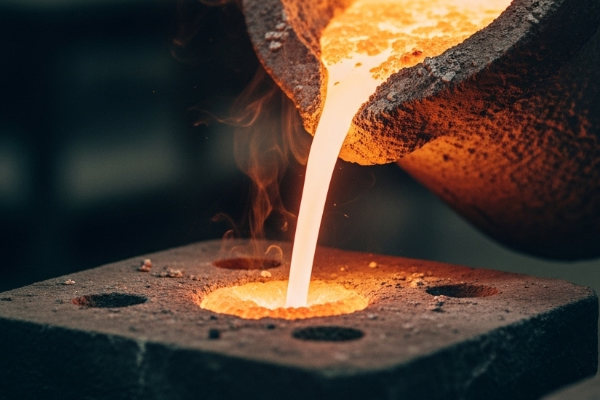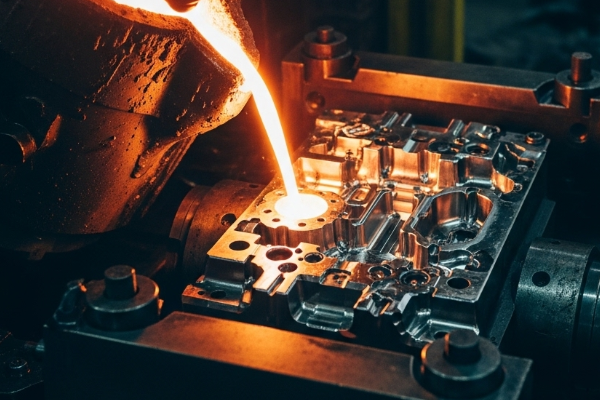
Privacy statement: Your privacy is very important to Us. Our company promises not to disclose your personal information to any external company with out your explicit permission.
If you’ve ever wondered how molten metal turns into the parts around you, or why casting remains so widely used, this guide will explain everything you need to know. We’ll cover what metal casting is, how the process works, the main types of casting, the products made through it, and why it’s still vital in modern industries.
At its core, metal casting is simple: molten metal is poured into a mold shaped like the desired part, allowed to solidify, and then removed and finished. The result is a solid metal component that can range from a small jewelry item to a massive engine block or structural beam.
What makes casting unique compared to other manufacturing processes like forging, machining, or 3D printing is its ability to:
Create very complex shapes in a single step.
Work with a wide range of metals, including iron, steel, aluminum, copper, and more.
Scale from single prototypes to millions of parts with the right process.
Handle parts of almost any size, from tiny electronics to large industrial machinery.
Casting is sometimes confused with forging (shaping solid metal by hammering or pressing) or machining (cutting away material to form a part), but it’s a fundamentally different process. By starting with liquid metal, casting can achieve shapes and internal geometries that would be impossible or extremely expensive with other methods.

Although the details can vary depending on the specific method used, most metal casting follows a general step-by-step process:
Every casting starts with a pattern, which is a replica of the final part (sometimes slightly larger to account for shrinkage as the metal cools). Patterns can be made of wood, plastic, wax, or metal, and they determine the cavity shape inside the mold.
The mold is what holds the molten metal until it solidifies. There are several ways to make molds:
Sand molds (for sand casting) use packed sand around the pattern.
Ceramic molds (for investment casting) are formed around a wax pattern.
Metal molds (for die casting or permanent mold casting) are machined from tool steel for repeated use.
The chosen metal or alloy is heated in a furnace until it reaches its liquid state. Foundries use electric, induction, or gas-fired furnaces depending on the material.
The liquid metal is carefully poured (or in some cases injected under pressure) into the mold cavity, filling every detail of the shape.
The filled mold is left to cool so the metal solidifies. Cooling rates are controlled to avoid defects and to achieve the desired material properties.
Once solid, the casting is removed. In expendable molds like sand or ceramic, the mold is broken away. For reusable metal molds, the part is ejected.
The rough casting often needs surface cleaning (removing sand, oxide, or excess metal) and finishing processes such as grinding, machining, or coating. Finally, parts undergo quality inspections to ensure they meet dimensional and structural requirements.
Each of these steps is critical. Poor pattern design, improper mold preparation, or incorrect pouring techniques can lead to defects like cracks, porosity, or shrinkage, which compromise the quality of the final product.
Casting is not just one process; there are several different techniques, each suited for different types of parts and production volumes. The most common include:
The most widely used casting method, sand casting uses a mold made from compacted sand. It’s highly versatile, allowing for very large parts and low-cost tooling, but the surface finish is rougher than other methods and tolerances are looser. Sand casting is ideal for engine blocks, pump housings, and heavy machinery.
Die casting uses a reusable metal mold (die) and injects molten metal into it under high pressure. This process produces high-Precision parts with excellent surface finishes at high volumes. It’s commonly used for automotive, electronics, and consumer products, especially with metals like aluminum, zinc, and magnesium.
In investment casting, a wax pattern is coated with ceramic to form a mold. The wax is melted out, and molten metal fills the cavity. This method can produce intricate, detailed parts with smooth finishes, making it popular for aerospace, medical, and jewelry applications.
Similar to die casting but without high-pressure injection, permanent mold casting uses a machined steel mold. It’s well-suited for medium production volumes and metals like aluminum and magnesium.
While less common, processes like centrifugal casting (for pipes and rings), shell molding, and lost foam casting are used for specific applications.

With so many modern manufacturing technologies, why is casting still so widely used? The reasons are simple:
Complex Geometries: Casting can produce shapes (including hollow sections and internal features) that would be costly or impossible with machining or forging.
Material Versatility: Nearly every commercial metal and alloy can be cast.
Scalability: From one-off prototypes to millions of parts, casting adapts to any volume.
Cost-Effectiveness: For many parts, especially complex ones, casting is more economical than machining or additive manufacturing.
Size Range: Casting can handle parts as small as a few grams or as large as several tons.
This flexibility makes casting essential for industries as diverse as automotive, aerospace, construction, medical, and consumer goods.
Casting is everywhere in our daily lives, even if you don’t realize it. Some examples include:
Automotive Parts: Engine blocks, cylinder heads, transmission cases, wheels, and suspension components.
Household Items: Cookware (cast iron skillets), plumbing fixtures, decorative hardware.
Industrial Equipment: Pump housings, valves, turbine casings, and machine bases.
High-Tech Applications: Jet engine turbine blades (investment cast), surgical implants, and precision tools.
Infrastructure and Public Items: Manhole covers, lamp posts, and park benches.
Whether it’s the car you drive, the appliances in your kitchen, or the tools in your garage, there’s a good chance casting played a role.
Like any manufacturing process, casting comes with potential challenges. Some of the most common defects include:
Porosity: Small holes caused by trapped gases.
Shrinkage: Cavities or voids from uneven cooling.
Cold Shuts and Misruns: Incomplete filling of the mold.
Cracks and Warping: Caused by stresses during cooling.
To avoid these issues, foundries rely on experienced engineers, precise process controls, and thorough quality inspections. Techniques like computer simulation are increasingly used to predict how metal will flow and solidify, allowing defects to be prevented before production begins.
Metal casting is a timeless yet modern process, combining the simplicity of pouring molten metal with advanced tools and techniques to produce everything from kitchenware to aerospace components. For thousands of years, it has enabled industries to create strong, complex, and cost-effective parts — and thanks to innovation, it’s more versatile and reliable than ever.
Understanding the basics of casting helps buyers, engineers, and enthusiasts make better decisions when choosing manufacturing methods. Whether you need a single prototype or millions of components, casting remains one of the most important and adaptable ways to bring metal products to life.
In the field of life sciences, biosafety cabinets (BSCs) are among the most critical pieces of laboratory equipment. They serve as primary containment devices that protect users, samples, and the environment from biohazardous agents. For manufacturers of BSCs, precision, hygiene, and compliance with international safety standards are non-negotiable.
Powder coating has long been associated with automotive, aerospace, and industrial applications due to its durability, cost-effectiveness, and environmentally friendly nature. In recent years, however, it has found a significant role in the medical and biotechnology sectors. These industries require surfaces that are not only strong and resistant to wear but also easy to clean, safe for sensitive environments, and compliant with strict regulatory standards. Powder coating, with its solvent-free application and highly customizable finishes, offers a unique combination of properties that makes it suitable for medical and biotech environments.
Discover why stainless steel fabrication is essential for cleanroom and laboratory environments. Learn its benefits in hygiene, safety, and compliance for pharmaceutical and biotech industries. CTT Technology delivers custom stainless steel solutions.
Metal casting is one of the oldest and most important methods of making metal parts. It has been used for thousands of years, from ancient civilizations creating tools and weapons to modern industries producing complex components for cars, planes, and electronics. Despite its long history, casting is far from outdated. In fact, it remains a cornerstone of today’s manufacturing world, with
Email to this supplier

Privacy statement: Your privacy is very important to Us. Our company promises not to disclose your personal information to any external company with out your explicit permission.